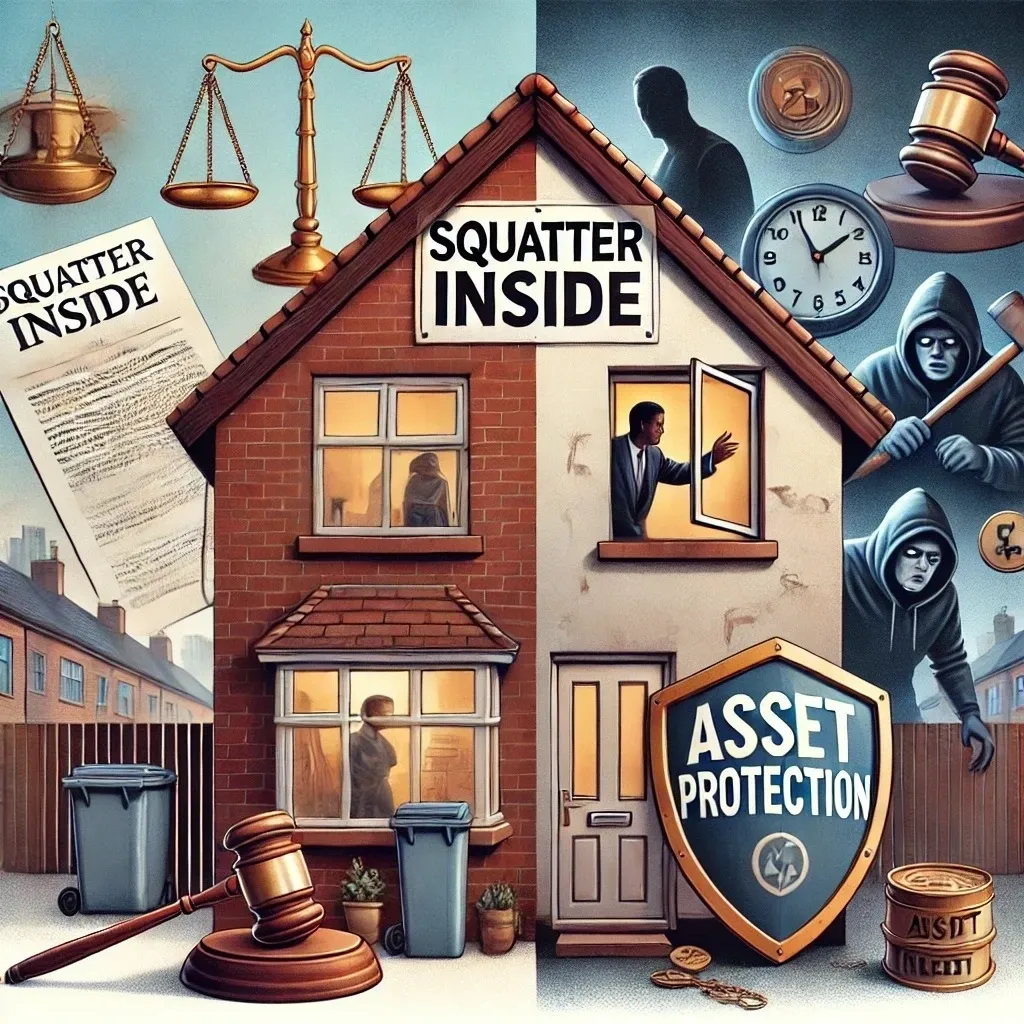Imagine hosting a lively gathering only to discover one guest who simply refuses to leave. This annoyance pales in comparison to the frustration of dealing with an uninvited individual who decides to take up residence on your property. This practice, known as “squatting,” has become a significant issue for many property owners in California and beyond.
A Brief History of Squatting
Why is squatting legal? The concept of squatting has deep historical roots that trace back to medieval England and common law. In those days, the king’s courts often ruled in favor of individuals who occupied properties without the owners’ consent, as long as the owner failed to take action within a specific timeframe. This practice developed as peasants sought to escape burdensome taxes by moving onto unclaimed land and establishing makeshift homes.
During the Wild West era in America, ranch owners could confront squatters directly and forcibly remove them from their lands. Fast forward to today, and the law has evolved dramatically. Nearly every state, including California, prohibits landlords from using force or threats to displace squatters. Instead, property owners must navigate legal channels and adhere to proper eviction processes.
Interestingly, ancient Welsh folk tradition supports the notion of squatting, asserting that if a person could build a home on common land in a single night, they could claim ownership. While such customs are relics of the past, their echoes resonate in today’s legal frameworks.
What is a Squatter?
A squatter is anyone who occupies a piece of property or land without any legal right to do so. This means they are not renting the property and do not have permission from the owner to use it. You might think an unauthorized occupant would be easy to remove from a residential or commercial property, especially without a rental agreement. However, a squatter—legally referred to as an adverse possessor—has rights that compel the rightful owner to engage in an official eviction process.
The rightful owner must act within a certain statutory period, which varies by state, to remove the squatter before they can claim legal title through adverse possession. This situation can transform your property from a potential passive income stream into a legal nightmare, underscoring the importance of regularly checking on real estate, particularly vacant properties.
What Are Squatter’s Rights?
Squatter’s rights, or “Adverse Possession,” allow an unauthorized occupant to remain on a property if the true owner fails to take legal action within a designated timeframe. The premise behind these rights is to discourage the use of vigilantism, which can escalate into dangerous situations. If landowners were permitted to employ force to remove squatters, the potential for violence increases, creating a climate of fear and instability.
This legal framework is similar to tenant rights, which protect renters from unscrupulous landlords. These laws delineate the rights of both parties involved, promoting stability in real estate markets and ensuring negotiations remain largely peaceful.
The Difference Between Squatting and Trespassing
While squatting is technically a form of trespassing, it goes a step further: squatters not only enter a property unlawfully, but they also intend to make an ownership claim and establish a permanent residence. Squatters often target unattended real estate, such as vacant buildings, which are more loosely monitored and easier to occupy legally.
In most cases, a property occupied by the owner does not fall under squatter’s rights laws, as the owner can remove a trespasser without going through eviction proceedings. In some states, property owners may employ reasonable force to remove trespassers, yet this is not the case for squatters.
How Do You Evict a Squatter from your Property?
To remove a squatter, it’s crucial to do so peacefully and legally—not through violence or threats. Here’s a breakdown of the steps you should follow:
1. Contact Local Law Enforcement: Your first move should be to call local law enforcement. While they may not be able to evict the squatter immediately, they can accompany you to the property to ask the squatter to leave and document the situation with a police report, which may be useful later in court.
2. File an Unlawful Detainer Action: The next step is to file an Unlawful Detainer Action. This process varies by state, so it’s advisable to enlist the services of an attorney. This legal action will formally notify the squatter that they must vacate the property, often through a notice served by a local sheriff.
3. Attend Court Hearings: If the squatter does not comply with the eviction notice, you may need to file a suit in court. This is typically classified as an unlawful detainer lawsuit. Both parties are required to attend this hearing. If the squatter fails to show up, the judge will likely rule in your favor, after which police may be ordered to forcibly remove the squatter.
4. Handle Leftover Belongings Carefully: Once the squatter is removed, don’t assume you can immediately toss their belongings. In many states, there are laws governing how to handle property left behind. It’s vital to bring written notice of what you intend to do with any remaining property to the court hearing. Consult your lawyer to ensure you follow the correct procedures. You may be prohibited from moving or disposing of the squatter’s belongings for a certain period, so tread carefully.
Do Squatters Pay Property Taxes?
In some instances, squatters may pay property taxes to strengthen their adverse possession claims. However, in many states, they are not required to do so as part of their claim process. That said, if a squatter occupies your property and pays the taxes, it is crucial that you continue to fulfill your tax obligations. Failing to do so could inadvertently validate their claims.
The Situation in California
In California, the challenges associated with squatting are increasingly pronounced. The state’s laws make it relatively easy for squatters to assert claims, leading to distressing experiences for property owners:
– 5-Year Rule: A squatter in California can potentially gain ownership after just **5 years** of continuous occupancy, provided they meet specific legal conditions, including paying property taxes.
– Rising Incidents: Reports of squatting in California are on the rise, especially in urban areas facing housing shortages. Squatters often target vacant homes, leading to disputes that can take months or years to resolve legally.
– Legal Complications: The eviction process can be lengthy and fraught with complications. Property owners may find themselves entangled in repeated court hearings and legal proceedings during which the squatter is allowed to occupy the property.
Protecting Your Property
Given the growing prevalence of squatting, property owners in California must take proactive measures to guard their investments:
1. Regular Inspections: Regularly check your property, particularly if it is vacant, to deter potential squatters.
2. Secure the Premises: Ensure that doors, windows, and access points are tightly secured to prevent unauthorized entry.
3. Seek Legal Advice: If you suspect squatters have moved onto your property, consult a qualified attorney experienced in real estate and tenant law to determine the best course of action.
4. Educate Yourself on Local Laws: Familiarize yourself with local laws regarding property rights and eviction processes to avoid being caught off guard.
The Importance of Asset Protection
Given the vulnerabilities associated with squatting and adverse possession, asset protection becomes a critical consideration for all property owners. Protecting your investments involves more than just managing them; it requires legal insights that can safeguard your rights and assets from unexpected claims, including those from squatters.
An Asset Protection Trust (APT) can be an effective tool for shielding your property. By creating an APT, you can achieve several key benefits:
– Legal Shielding: An APT can protect your assets from creditors, including claims stemming from unauthorized occupants, by establishing them as owned by the trust rather than in your name.
– Simplified Transfer Process: In the event of disputes or deaths, properties held in an APT can be managed according to the trust’s terms, reducing complications related to squatter claims about ownership.
– Tax Advantages: An APT can also help maintain mortgage interest deductions and preserve capital gains benefits on residential sales, unlike some other asset protection strategies.
– Proactive Management: With an APT, you can incorporate proactive management processes that ensure timely action is taken against potential squatters before they can establish legal claims.
Conclusion
Squatter’s rights present a daunting challenge for property owners, particularly in states like California with lenient laws regarding adverse possession. Awareness of the historical context and legal framework surrounding squatting, alongside proactive measures such as asset protection strategies, is essential for safeguarding your property from unauthorized occupants.
Don’t hesitate to reach out to our law firm for personalized and effective asset protection support. Investing in asset protection isn’t just wise; it’s essential for anyone serious about preserving their property rights. Your property deserves robust protection, and we are here to help you navigate the complexities.
Call us for a legal consultation and talk with an asset protection lawyer at (888) 773-9399.
By: Brian T. Bradley, Esq.




